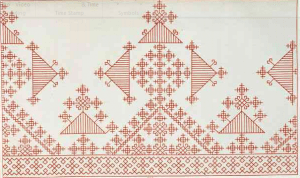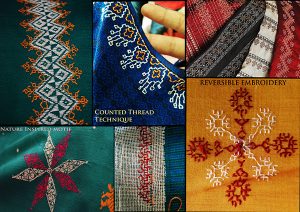Are you looking for The Kasuti Of Karnataka then check out this post to know more. Kasuti is a world famous embroidery of Karnataka (state of India), earlier known as Mysore State. The motifs and the art speak about the tradition, customs, and profession of the people of Karnataka. The age of learning and executing Kasuti was common to both royals, aristocrats and peasant women. It is said that the Kasuti resembles the embroidery of Austria, Hungary, and Spain.

The Kasuti Of Karnataka
The origin of Kasuti is not known. The word Kasuti can be analyzed as ‘kai‘ meaning hand and ‘suti’ meaning cotton thread, i.e.a hard work of cotton thread in Kannada, the local language of Karnataka.
The lingayats, the follower of cult Shiva, also known the Verrasaivas are expert in older ladies in the family and was done on saris and blouses. The motifs and stitches were sometimes tried out on a piece of white cotton cloth which was preserved as a model.
Other centers of production are Bilaspur, Dharwar, belgam and Jamakhandi districts of India.
FABRIC, THREADS, STITCHES USED
Fine silk fabric of the sarees was used earlier in addition to this, canvas or fine matty is used now. The base color is dark, usually black or dark blue. Traditionally the thread was drawn from the vessels of the Pallava of the saris, to make the design appear flat, rich and gorgeous, DCM, Anchor, Kohinoor. Cotton threads are used. The color most frequently used are red-blue, red-yellow, red-white and green-yellow. Bright contrast is used to make a bold and clear design.
Stitches in Kasuti are always vertical, horizontal and diagonal. the main specialty of this embroidery is that never the design is traced in the material to be embroidered and embroidery starts without knotting thread but with a tiny back stitch. The stitches are simple, minute, intricate and pretty. Kasuti is done always by counting the threads. The four types of stitches are Gavanti, Murgi, and Negi. Different patterns and motifs are worked in different stitches but some have mixed stitches.

One can find fine traces of this embroidery in salwar suits and dress materials as well. Employing various kasuti weavers by bringing in the tradition of this embroidery in sarees and dress materials gives out a splendid present time for the Dharwad sarees. The materials are not limited to Cotton anymore. They have started ranging from Silk to other varieties including Nylon. Kasuti embroidery has now spread to furniture covers and splendid curtains also. The rustic motifs are an interesting version of the kasuti embroidery that has driven the innovations in. With classic designs and beautiful embroidery, kasuti gives out an amazing collection of furniture wear.



